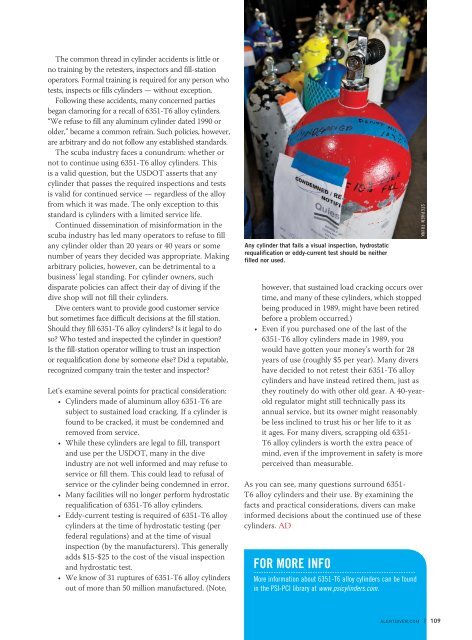AD 2017 Q4
Alert Diver is the dive industry’s leading publication. Featuring DAN’s core content of dive safety, research, education and medical information, each issue is a must-read reference, archived and shared by passionate scuba enthusiasts. In addition, Alert Diver showcases fascinating dive destinations and marine environmental topics through images from the world’s greatest underwater photographers and stories from the most experienced and eloquent dive journalists in the business.
Alert Diver is the dive industry’s leading publication. Featuring DAN’s core content of dive safety, research, education and medical information, each issue is a must-read reference, archived and shared by passionate scuba enthusiasts. In addition, Alert Diver showcases fascinating dive destinations and marine environmental topics through images from the world’s greatest underwater photographers and stories from the most experienced and eloquent dive journalists in the business.
Create successful ePaper yourself
Turn your PDF publications into a flip-book with our unique Google optimized e-Paper software.
The common thread in cylinder accidents is little or<br />
no training by the retesters, inspectors and fill-station<br />
operators. Formal training is required for any person who<br />
tests, inspects or fills cylinders — without exception.<br />
Following these accidents, many concerned parties<br />
began clamoring for a recall of 6351-T6 alloy cylinders.<br />
“We refuse to fill any aluminum cylinder dated 1990 or<br />
older,” became a common refrain. Such policies, however,<br />
are arbitrary and do not follow any established standards.<br />
The scuba industry faces a conundrum: whether or<br />
not to continue using 6351-T6 alloy cylinders. This<br />
is a valid question, but the USDOT asserts that any<br />
cylinder that passes the required inspections and tests<br />
is valid for continued service — regardless of the alloy<br />
from which it was made. The only exception to this<br />
standard is cylinders with a limited service life.<br />
Continued dissemination of misinformation in the<br />
scuba industry has led many operators to refuse to fill<br />
any cylinder older than 20 years or 40 years or some<br />
number of years they decided was appropriate. Making<br />
arbitrary policies, however, can be detrimental to a<br />
business’ legal standing. For cylinder owners, such<br />
disparate policies can affect their day of diving if the<br />
dive shop will not fill their cylinders.<br />
Dive centers want to provide good customer service<br />
but sometimes face difficult decisions at the fill station.<br />
Should they fill 6351-T6 alloy cylinders? Is it legal to do<br />
so? Who tested and inspected the cylinder in question?<br />
Is the fill-station operator willing to trust an inspection<br />
or requalification done by someone else? Did a reputable,<br />
recognized company train the tester and inspector?<br />
Let’s examine several points for practical consideration:<br />
• Cylinders made of aluminum alloy 6351-T6 are<br />
subject to sustained load cracking. If a cylinder is<br />
found to be cracked, it must be condemned and<br />
removed from service.<br />
• While these cylinders are legal to fill, transport<br />
and use per the USDOT, many in the dive<br />
industry are not well informed and may refuse to<br />
service or fill them. This could lead to refusal of<br />
service or the cylinder being condemned in error.<br />
• Many facilities will no longer perform hydrostatic<br />
requalification of 6351-T6 alloy cylinders.<br />
• Eddy-current testing is required of 6351-T6 alloy<br />
cylinders at the time of hydrostatic testing (per<br />
federal regulations) and at the time of visual<br />
inspection (by the manufacturers). This generally<br />
adds $15-$25 to the cost of the visual inspection<br />
and hydrostatic test.<br />
• We know of 31 ruptures of 6351-T6 alloy cylinders<br />
out of more than 50 million manufactured. (Note,<br />
Any cylinder that fails a visual inspection, hydrostatic<br />
requalification or eddy-current test should be neither<br />
filled nor used.<br />
however, that sustained load cracking occurs over<br />
time, and many of these cylinders, which stopped<br />
being produced in 1989, might have been retired<br />
before a problem occurred.)<br />
• Even if you purchased one of the last of the<br />
6351-T6 alloy cylinders made in 1989, you<br />
would have gotten your money’s worth for 28<br />
years of use (roughly $5 per year). Many divers<br />
have decided to not retest their 6351-T6 alloy<br />
cylinders and have instead retired them, just as<br />
they routinely do with other old gear. A 40-yearold<br />
regulator might still technically pass its<br />
annual service, but its owner might reasonably<br />
be less inclined to trust his or her life to it as<br />
it ages. For many divers, scrapping old 6351-<br />
T6 alloy cylinders is worth the extra peace of<br />
mind, even if the improvement in safety is more<br />
perceived than measurable.<br />
As you can see, many questions surround 6351-<br />
T6 alloy cylinders and their use. By examining the<br />
facts and practical considerations, divers can make<br />
informed decisions about the continued use of these<br />
cylinders. <strong>AD</strong><br />
FOR MORE INFO<br />
More information about 6351-T6 alloy cylinders can be found<br />
in the PSI-PCI library at www.psicylinders.com.<br />
STEPHEN FRINK<br />
ALERTDIVER.COM | 109









